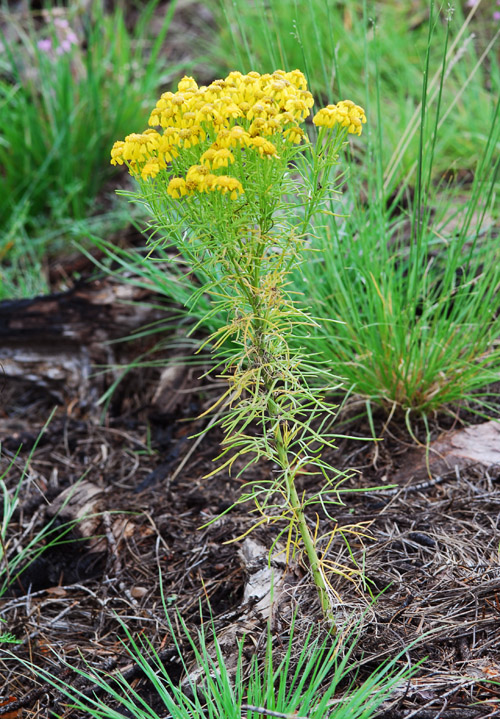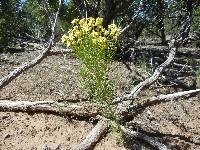Hymenoxys brachyactis
|
|
|
|
Family: Asteraceae
East View Rubberweed
|
Biennials or perennials, 30-60 cm (monocarpic; sometimes with sparingly branched, woody caudices). Stems 1-4(-8), green throughout, branched distally, glabrous or sparsely hairy. Leaves: blades simple or lobed (lobes 3-9), glabrous, gland-dotted; mid leaves lobed (lobes 3-7, terminal lobes 0.8-1 mm wide). Heads (7-)40-150(-250) per plant, in paniculiform to corymbiform arrays. Peduncles 1.2-2 cm, glabrous or sparsely hairy. Involucres usually urceolate, sometimes campanulate, 6-8 × 5-6 mm. Phyllaries in 2 series, unequal; outer 8(-9), basally connate 1/2 their lengths, lanceolate, 4-6 mm, apices acuminate to acute; inner 8(-10), obovate, 4.5-5 mm, apices mucronate. Ray florets 8(-9); corollas yellow, 7-8.5 × 3-4(-4.8) mm. Disc florets 25-60+; corollas 3.1-4.2 mm. Cypselae narrowly obpyramidal, 2.1-2.5 mm; pappi of 5(-7) obovate to lanceolate, aristate scales 2.5-3 mm. Flowering Jul-Sep. Roadsides, open areas, edges of pine forests; 2000-2500 m; N.Mex. Allred and Ivey 2012, FNA 2006, NM Rare Plant Technical Council 2005 Duration: Biennial/Perennial Nativity: Native Lifeform: Forb/Herb General: Biennial or monocarpic perennial herbs, 30-60 cm tall, from a simple or sparingly branched woody caudex. Stems usually solitary, branching above the middle, green throughout, glabrous or sparsely hairy. Leaves: Basal leaves withered by the flowering season; stem leaves numerous; blades pinnatifid with narrowly linear lobes, glabrous, gland-dotted. Flowers: Flower heads yellow, showy and radiate, 40-150 or more in flat topped panicles; involucres usually urceolate (urn-shaped), sometimes campanulate (bell-shaped), 6-8 mm high and 5-6 mm wide, the bracts (phyllaries) in two unequal series; outer series of 8-9 phyllaries, united for the lower 1/3 to 1/2 of their lengths, lanceolate, 4-6 mm long, with pointed tips; inner series of 8 phyllaries, these not united at the base, 5 mm long, obovate with mucronate tips, and ciliate margined; ray florets 8 per flower head, the laminae (ray petals) 7-9 mm long and 3-4 mm wide, yellow; disc florets 25-60+ per flower head, 3-4 mm high, yellow. Fruits: Achenes narrowly obpyramidal, 2 mm long; topped with a pappus of 5-7 obovate scales, these 3 mm long. Ecology: Found on roadsides, in open areas, and edges of pine forests, from 6,900-8,200 ft (2103-2499 m); flowers July-September. Distribution: Endemic to central New Mexico, in Lincoln, Sierra, Soccorro, and Torrance Counties Notes: H. brachyactis is endemic to a quite limited area in central New Mexico. It is distinguished from other Hymenoxys spp. by this suite of characters: it is monocarpic, meaning that it only flowers once and then dies; plants emerge from simple unbranched caudices and each plant consists of a single stem which branches above the base; the panicle has a large number flower heads, and the heads are less than 1 cm high, smaller than many other Hymenoxys spp; and the length of the ray florets is less than the length of the involucre. It might be confused with H. richardsonii, but that species is a perennial with a branching woody caudex and many stems per plant. Ethnobotany: Unknown Etymology: Hymenoxys comes from Greek hymen, meaning membrane, and oxys, meaning sharp or sharp pointed, referring to the awned pappus scales; brachyactis means short rays. Editor: AHazelton 2017 |


